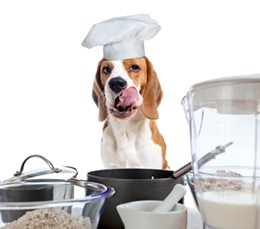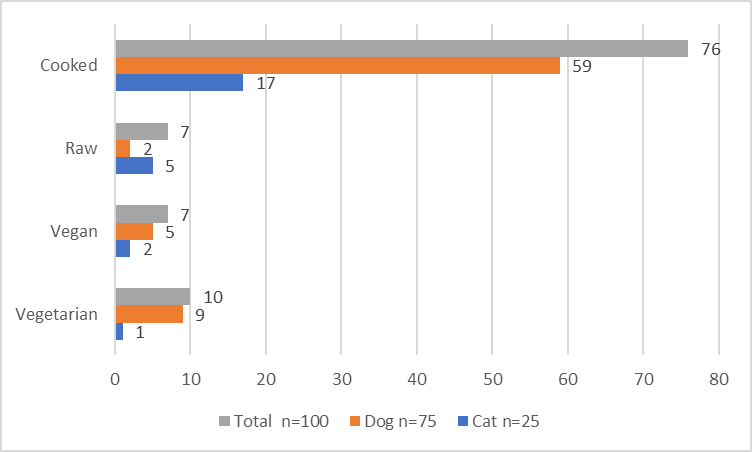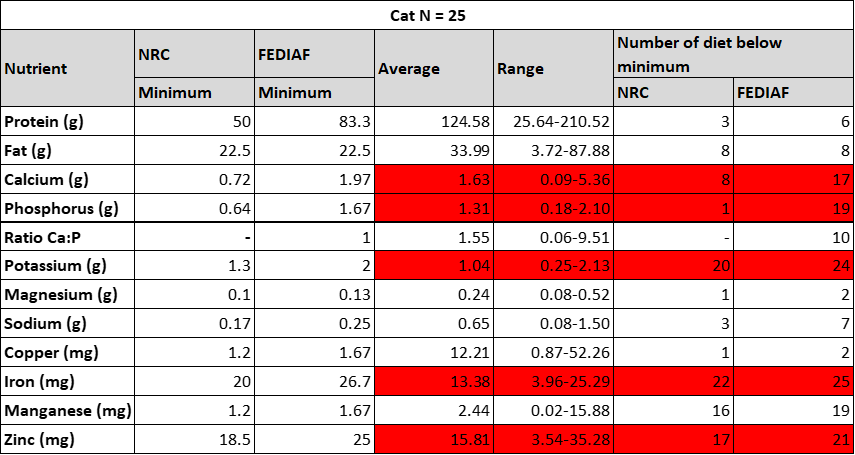Preparing Homemade Food for Our Pets – Things to Consider!
 This article was written by Guest Author, Sophie Lavallée, M.Sc Agronomist
This article was written by Guest Author, Sophie Lavallée, M.Sc Agronomist
Homemade food is often inadequate to meet the basic nutritional needs of dogs and cats. This was revealed in a new Brazilian study published in September in Scientific Reports. Researchers from the School of Veterinary Medicine and Animal Science in Sao Paulo have shown that none of the 100 diets evaluated fully meet the nutritional requirements established by the National Research Council (NRC) and the European Federation of the Food Industry for Pets (FEDIAF).

CRÉDIT : Dogzone https://www.dogzone.com/
The recipes, evaluated outside the standards, implied protein, lipid and mineral deficiencies. The majority of the imbalances were found in calcium, phosphorus, potassium, zinc and iron. The researchers found 3 or more nutrients below the recommendations in 84% of the recipes for dogs, and 100% of the recipes for cats. The health problems caused by a nutritional imbalance remain many and varied. One of the most common nutritional diseases is secondary nutritional hyperparathyroidism, a disease of the thyroid gland, resulting from a lack of calcium and excess phosphorus.
Of the 100 recipes evaluated, 75 were for healthy adult dogs, 12.0% of which were vegetarian and therefore excluded meat, and 6.6% were vegan, thus omitting ingredients of animal origin. In terms of cooking, 2.7% of dog recipes contained raw animal products, while the rest were cooked. For recipes for adult cats, 4.0% were vegetarian and 8.0% were vegan, 20% contained raw animal ingredients and the rest were cooked.

Figure 1. Diet profile assessed (n) by researchers
The researchers report that clinical signs of nutritional deficiency in dogs and cats are observed more rapidly during the growing period due to higher nutritional demand. While in adult animals, symptoms are slower to appear. The majorities of the vegetarian and vegan diets for dogs and cats evaluated had protein levels below FEDIAF recommendations. Protein recommendations are based on the need for essential amino acids (AAEs). AAEs are the building blocks of body proteins found in muscles, blood, hormones, enzymes. Therefore, if the concentration of protein in the food is lower than recommended, one can assume that one or more amino acids do not cover the daily need
The main nutrients in deficiencies compared to the standards of NRC and FEDIAF
The majority of imbalances were in the calcium, phosphorus, potassium, zinc and iron elements.


Table 1. Average nutrient analysis results (per 1000 kilocalories of metabolizable energy) of 75 dog diets and 25 cat diets and comparison with NRC and FEDIAF standards.
Other studies in North America
These results corroborate those published in June 2013, and then in May 2019 in the journal American Veterinary Medical Association (AVMA) by another team of researchers from the School of Veterinary Medicine at the University of California, Davis. These researchers demonstrated that out of 200 recipes for dog food prepared at home, less than a dozen provided all the essential nutrients in sufficient quantity to meet the standards established by the Association of American Feed Control Official (AAFCO). AAFCO is used to establish uniform standards for the animal feed industry in North America.
In all cases, the researchers indicate that the formulation of diets prepared at home must be provided by a qualified professional in order to minimize the risks of nutritional deficiency and to improve the health and quality of life of dogs and cats.
We hope you enjoyed learning more about homemade diet and potential nutritional risks for pet. Feel free to contact us should you have any questions on this subject.
References:
1- Agence France-Presse. In Brazil, there are more dogs than children. June 2015. https://www.lapresse.ca/vivre/animaux/201506/02/01-4874618-au-bresil-il-y-a-plus-de-chiens-que-denfants.php page consulted on 4 Nov 2019.
2- American Veterinary Medical Association (AVMA). Raw Pet Foods and the AVMA’s Policy: FAQ https://www.avma.org/KB/Resources/FAQs/Pages/Raw-Pet-Foods-and-the-AVMA-Policy-FAQ.aspx
3- American Veterinary Medical Association (AVMA). US Pet Ownership Statistics, AVMA, 2017-2018 US Pet Ownership & Demographics Sourcebook https://www.avma.org/KB/Resources/Statistics/Pages/Market-research-statistics-US-pet-ownership.aspx Page consulted on Nov 4, 2019.
4- Davies R. H., J. R. Lawes, A. D. Wales. Raw diets for dogs and cats: a review, with particular reference to microbiological hazards. Journal of small animal practice, April 2019 https://onlinelibrary.wiley.com/doi/10.1111/jsap.13000
5- Dodd, S. A. S., Cave, N. J. & Verbrugghe, A. Changes in the feeding practices of domestic dogs and cats over the last decade. In ESVCN Proceedings 2018 227 (ESVCN, 2018).
6- FEDIAF. Nutritional Guidelines for Complete and Complementary Pet Food for Cats and Dogs. (European Federation of the Pet Food Industry, 2018).
7- Human Food Trends and the Potential Impact on Pet. James Restivo presented @ The Watt Media Webinar, September, 11, 2018
8- Laflamme DP, et al. Pet feeding practices of dog and cat owners in the United States and Australia. J. Am. Vet. Med. Assoc. 2008; 232: 687–694. https://avmajournals.avma.org/doi/abs/10.2460/javma.232.5.687
9- NRC. Nutrient Requirements of Dogs and Cats. (National Academy Press, 2006)
10- Pedrinelli V., R. V. Zafalon, R. B. Rodrigues, M. P. Perini, R. M. Consentino, T. H. Vendramini, J. C. Balieiro, M. A. Brunetto. Concentrations of macronutrients, minerals and heavy metals in home-prepared diets for adult dogs and cats, Sept 2019 https://www.nature.com/articles/s41598-019-49087-z Page consulted on Nov 4, 2019.
11- Stockman J., A Fascetti, P. Kass, H. Kass, J.A. Larsen. Evaluation of recipes of home-prepared maintenance diets for dogs. Journal of the American Veterinary Medical Association, May 2013, 242 (11): 1500-1505 https://avmajournals.avma.org/doi/abs/10.2460/javma.242.11.1500



